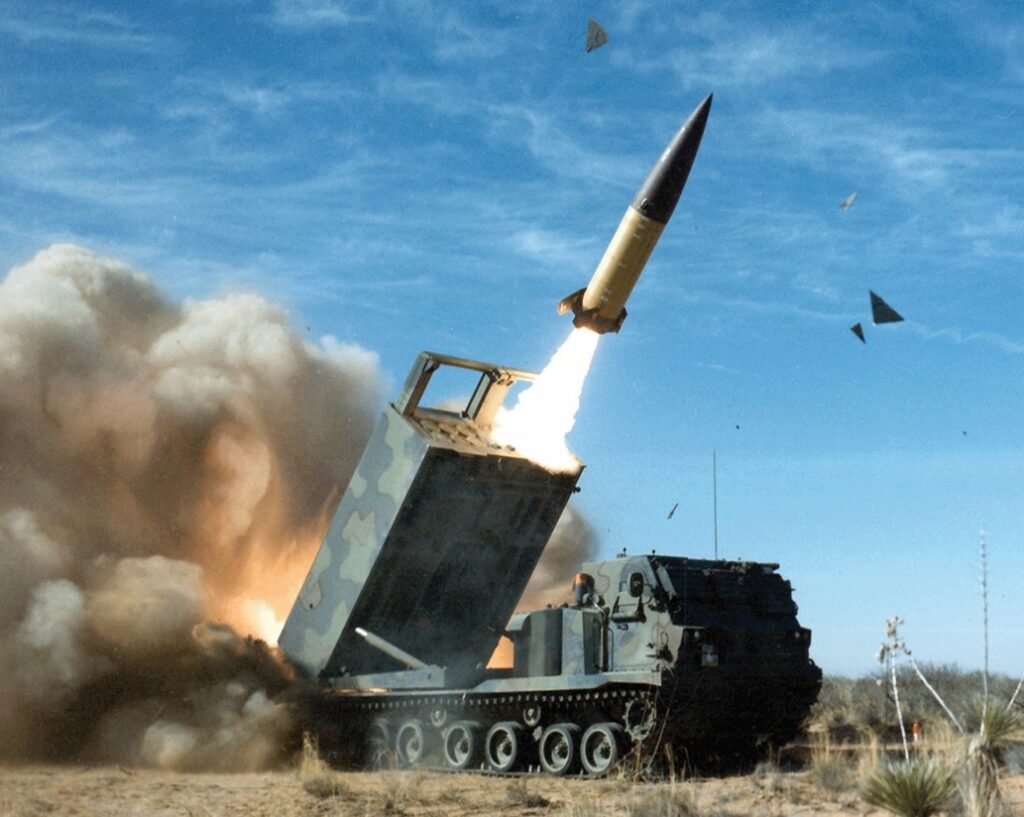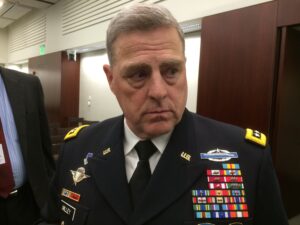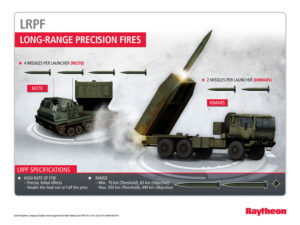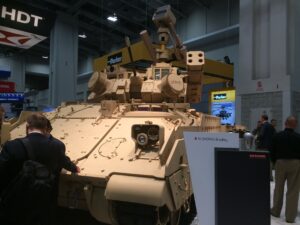
Army ATACMS missile launch.
UPDATED: McCain Endorses Army Move
AUSA: Army leaders are creating eight interdisciplinary teams to jumpstart modernization programs in six key areas, from (non-nuclear) ballistic missiles to body armor. Each team will be led by a battle-hardened brigadier general and consist of specialists drawn from across the Army.

Gen. Mark Milley
These Cross Functional Teams are linked to a much larger reorganization of Army acquisition now being studied, with detailed options due back in early January to Chief of Staff Mark Milley and Acting Secretary Ryan McCarthy.
UPDATE Senate Armed Services Chairman John McCain, a frequent critic of Pentagon procurement and the Army in particular, said he “welcomes” the reorganization plan: “The Army’s decision to restructure its acquisition process and streamline its modernization program is an example of the kind of bold steps that will be necessary to fix a broken system.”

John McCain
Sec. McCarthy “has approved the concept of a new modernization or futures command, to consolidate the processes that inform and deliver Army capabilities and put them all under one roof,” Gen. Milley said today at the Association of the US Army’s annual conference. “This is a significant change that will unfold over the next year and we will move quickly, because time is not on our side. The new command will be formed from existing structure and it will combine elements of army futures, concept developments, requirements, and acquisition.”
But the CFTs themselves are a pilot project superimposed on existing Army organizations, and their establishment will begin immediately “upon receipt of this directive,” according to an Oct. 6 memo shared with reporters and reproduced below. (Note to old hands: this all sounds a lot like OSD’s old Integrated Product Teams.)
Army Acquisition Reform CFTs by BreakingDefense on Scribd
The team’s role is limited, at least for now, not replacing traditional weapons programs but informing them. They’ll write requirements – the official wishlist for what each item of equipment has to do – and may conduct field experiments as well:
“The concept for the CFT is to develop a requirement, informed in appropriate cases by experimentation and technical demonstrations, through teaming, agility, and rapid feedback to enable the development of a capability document and improve the decision making for a potential program of record.”
To do this job, each team will draw on a host of Army specialties and organizations, from Training & Doctrine Command‘s intellectual priesthood to theater commands‘ pragmatic practitioners: “Requirements, Acquisition, Science and Technology, Test and Evaluation, Resourcing, Contracting, Costing, Acquisition Logisticians, and U.S. Army Forces Command (FORSCOM) (as well as Army Service Component Commands as applicable). The CFTs will also leverage industry and academia where appropriate to help inform the capabilities development process.”
The one-star general leading each team will report directly to the uniformed Vice-Chief of Staff and the civilian Under Secretary of the Army. It’ll be the vice chief who picks the brigadiers, with advisors from across the Army.

M1 tanks of 3rd Armored Brigade Combat Team, 4th Infantry Division, await unloading in Bremerhaven, Germany in January.
The Priorities
The eight teams match up to the six priorities – which Gen. Milley said yesterday are in order – as follows, with some priorities requiring more than one team:

Raytheon’s proposal for the new Long-Range Precision Fires (LRPF) weapon.
Long Range Precision Fires: The Army already has a program called LRPF, meant to replace the Cold War ATACMS missile. This team’s purview is broader: “Land power without overwhelming fires from artillery and joint systems will never succeed in high-intensity combat, so we are going to rapidly modernize Army rocket and tube artillery,” Milley said, referring to both missiles and howitzers. “(It will) strike with land based precision fires at very extended ranges that our enemy will never expect, well beyond what we have now.” This portfolio probably also includes land-based anti-ship missiles to help the Navy control the seas.
Next Generation Combat Vehicle: This is the nascent effort to replace the Army’s current M1 Abrams tanks and M2 troop carriers, designed in the 1970s, with new vehicles that are “10 times” as capable. That means more firepower – perhaps railguns or lasers – and new forms of protection on lighter war machines that need less fuel and transport to reach the fight. Milley wants to “leverage new technologies in firepower mobility, armor, materials, active protection systems.,lighter weight, new forms of power generation beyond carbon based fuels, and importantly, robotics.” Unlike long-range fires or Future Vertical lift (below), there’s no program to build these vehicles yet, just research and exploration of options with a go/no-go decision to start work on prototypes around 2022. NGCV would be the second most expensive modernization effort, second only to FVL.

The Sikorsky-Boeing SB-1 Defiant concept for the Joint Multi-Role demonstrator, a predecessor to the Future Vertical Lift aircraft.
Future Vertical Lift: Another long-term effort, FVL aims to replace 1970s helicopter designs with radically new kinds of aircraft that can fly faster, farther, and higher. Unlike the ground vehicle program, FVL has funded two prototypes – the Joint Multi-Role Technology Demonstrators – one of which is already in ground testing. Unlike the other five priorities, FVL is also a joint effort, with the Army leading some elements but the Marines, Air Force, and Navy equal partners.
Networks: This area is so complex and critical it gets two Cross Functional Teams. One looks at networked Command, Control, Communications, and Intelligence (C3I), the whole array of computerized functions that allow scattered troops to coordinate their actions – a system with which Gen. Milley is deeply dissatisfied, halting the Army’s top network program, WIN-T, for being too vulnerable to Russian hacking and jamming. Milley wants the future network to be “expeditionary, mobile ,and hardened to survive in an active electronic warfare environment (and) leverage emerging technologies of artificial intelligence and machine learning.” The other team looks at Assured Precision Navigation and Timing (APNT), the urgent need to find alternatives to a GPS signal that, again, a sophisticated adversary can jam.

A BAE Systems M2 Bradley modified with sensors and weapons to shoot down aircraft and drones.
Air and Missile Defense: “None of the above will matter unless you have this fifth priority,” MIlley said. “It won’t matter if you are dead.” This is the flipside of long-range precision fires – trying to stop the enemy’s missiles, rockets, artillery rounds, helicopters, airstrikes, and drones. Missile defense systems like THAAD and Patriot address the high-performance threats, although they can be drowned by massive incoming salvos, pushing the military to consider high-tech supplements like lasers and railguns. The bigger gap is against aircraft, artillery, and drones. The Army has a Maneuver SHORAD (Short-Range Air Defense) initiative that recently tested several contractors’ anti-aircraft systems at White Sands, though there’s no definitive timeline to buy something.
Soldiers: Everything the Army does comes down to individual soldiers on the ground. (The Marines are similar, while the Navy and Air Force always fight in machines). While the last area on the priority list, soldier capabilities still gets two separate Cross Functional Teams. One is working on Soldier Lethality – making troops more effective in combat: “We intend to significantly increase investments (in) body armor, individual sensors, small unit radios, load-bearing exoskeletons…. and much much more,” Milley said.
The other team will work on Synthetic Environment Training – in essence, advanced simulations to better prepare for complex scenarios you can’t replicate in a training area on-base. “We will always emphasize live fires and exercises,” Milley said, but those are expensive and you can’t do them all the time. So he wants multiple simulators in every company so troops can practice “fighting every day.” After all, we spend millions on training a single fighter pilot, much of it in sophisticated simulators, the general said: “Any soldier that engages in close quarters combat deserves the same investment.”
Sullivan says Ukraine supplemental should cover all of 2024, long-range ATACMS now in Ukraine
“We now have a significant number of ATACMS coming off their production line and entering US stocks,” Jake Sullivan said today. “And as a result, we can move forward with providing the ATACMS while also sustaining the readiness of the US armed forces.”


























